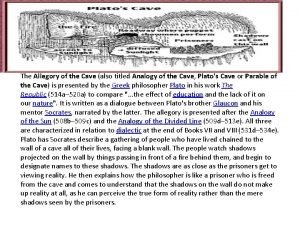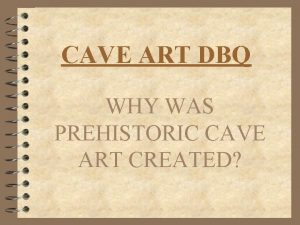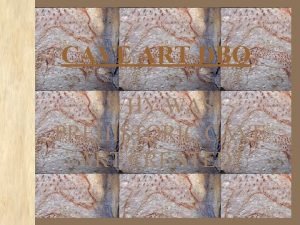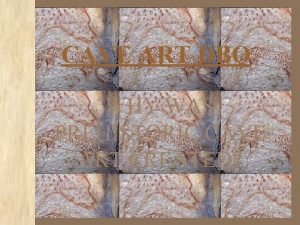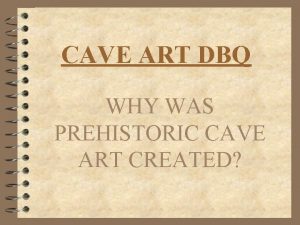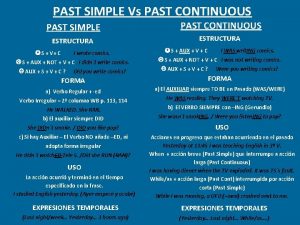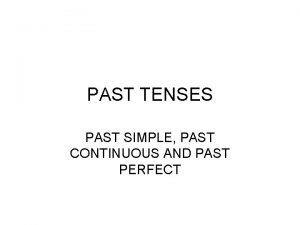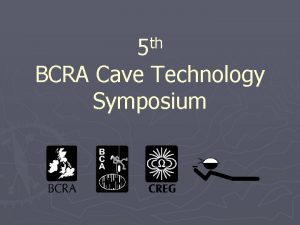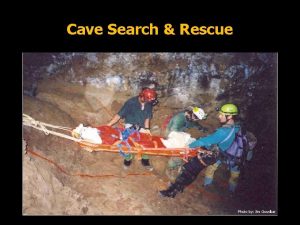Investigating the Past Cave Art Section I Cave



















- Slides: 19

Investigating the Past: Cave Art

Section I: Cave Art Treasures of the Past

What is cave painting? • Drawing, stencil art and painting on the walls and ceilings of prehistoric caves • Evidence indicates it began around 30, 000 B. C. E

1. 3 Cave Art: Treasures of the Past • Caves with paintings thousands of years old have been found all over the world. • The paintings show what animals roamed the earth.

Where are most cave paintings found? • Many of the rooms that are decorated with paintings are deep inside the caves. • Some were large and taller than a person. • Scientist guess that cave artists built scaffolding or planks raised above the floor to reach, the highest places.

1. 4 Cave Painting of a Human • Paintings of humans are rare in cave art. • Most scientist think this painting was created as part of a hunting ritual. • The artist may have been asking for a successful hunt. • Or the painting might be a record of an actual event or simply a decoration.

1. 5 Paintings of Animals • Scientist have many ideas why animal paints were created. • Some believe that the artists tried to capture the “magical powers” of certain animals. • Some think the painters believe in spirits and created the art to honor or influence them.

1. 6 Cave Paintings or Shapes and Handprints • Paintings of shapes and handprints are fairly common • Their meaning, however, is a mystery! • Many scientist believe that the handprints were the way an artist signed a painting.

1. 7 Spear Thrower • Found in France • Made from reindeer antler bone. • 18, 000 years ago Scientist believe that the artist carved the horse for decoration. It could have been a good-luck charm to protect the hunter.

1. 8 Clay Sculptures • Made about 10, 000 to 14, 000 years ago. • 23 inches long • Sculpted from gold colored clay Social Scientist have a few theories about this artifact: 1. It showed the cave belonged to a certain clan. 2. The sculptures were used in a coming-of-age ceremony to show a child had become an adult. Evidence that support this are the foot prints of young people have been found near the sculptures.

1. 9 Cave Art Tools • Engraving tools • Colored, rock-hard minerals • Grindstone for grinding the minerals Scientist believe that cave artist made paintings by grinding colored minerals into powder. They probably mixed the powder with animal fat or vegetable oil to get different colors.

1. How did it feel to explore a cave and learn about early hominids? 2. What do you think was similar about your cave exploration and what real social scientists do when they explore a cave? What do you think might be different? 3. How did your interpretations of early hominids change as you uncovered new information? 4. Based on evidence you gathered, what do we know for certain about the early hominids who left their marks on these caves? 5. What are some questions that still remain to be answered by future social scientist?

Essential Questions • How do social scientist construct and evaluate stories of the past? • What do artifacts tells us about the people who created them?

How do social scientist construct and evaluate stories of the past? • Social Scientist examine artifacts to determine why the creator made it. • They use information they know about artifacts and then try to find a relationship between them. • They make hypotheses about how they think the creators lived and what they believed. • They can determine who, what, when and why by analyzing artifacts.

What do artifacts tells us about the people who created them? • Shows that the creator had intelligence • It tells what they might do for entertainment • Resources that the creator might have had such as minerals to create paint. • Whether the people were hunters because they painted many animals and scenes from hunts.


Processing: Create a Cave Painting • Create a cave drawing about YOURSELF! • Select at least 5 items that represents the most important aspects of your life. What would you want remembered 20, 000 years from now?

Rough Draft • Create a rough draft in your workbook on page 12. • Once you are approved by a teacher you will receive a piece of black butcher paper and a few pieces of chalk for your final draft. • Be sure to sign your final draft with your hand prints!

 Allegory of the cave and fahrenheit 451
Allegory of the cave and fahrenheit 451 Cave art definition
Cave art definition Investigating the properties of sound
Investigating the properties of sound Investigating science hsc
Investigating science hsc Practice a investigating graphs of polynomial functions
Practice a investigating graphs of polynomial functions Investigating graphs of polynomial functions
Investigating graphs of polynomial functions Unit 14 customer service
Unit 14 customer service Investigating the world of work. lesson 1
Investigating the world of work. lesson 1 6-7 investigating graphs of polynomial functions
6-7 investigating graphs of polynomial functions Unit 14 investigating customer service assignment 1
Unit 14 investigating customer service assignment 1 Investigating the graph of an inequality
Investigating the graph of an inequality Digital graphics to entertain
Digital graphics to entertain Investigating polynomials
Investigating polynomials Investigating system requirements
Investigating system requirements Science 14 module 1 answer key
Science 14 module 1 answer key How is a delta formed
How is a delta formed Investigating graphs of polynomial functions
Investigating graphs of polynomial functions Investigating quadratics
Investigating quadratics Investigating rivers
Investigating rivers Investigating skills thomas edison
Investigating skills thomas edison
